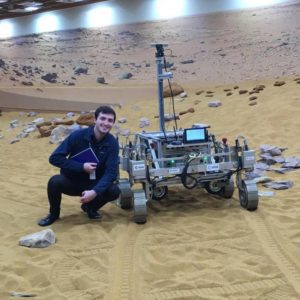In summer 2017, I was offered an internship with CPOM. I had just graduated with my Physics BSc and was about to begin a graduate scheme as an Electronics Engineer; but my interest in Earth Science had been piqued by an optional module I took within the department in my final year at University of Leeds. I enjoyed my degree but had quickly realised that the highlights for me were the hands-on aspects such as making an FM radio in my labs and programming a maze-solving robot for my final year project. This is what led me to pursue a career in engineering – the idea of taking a concept in physics and applying it to a variety of interesting real-world situations was something I was quickly becoming passionate about.
It turns out that earth science can be very similar to engineering in that regard! In the earth observation module, we learned about how physics and geology underpin the fields of glaciology, bathymetry, and others. Learning about how data gathered in space was informing research conducted on earth fascinated me, which is why I found myself coming back to the department for the summer.
Over a six-week period, I looked at altimetry data from CryoSat-2 and analysed changing sea ice thickness trends across the Northern Sea Route over Russia and the Northwest Passage over Canada. Each year it appears to be thinner, and more cargo ships are braving the widening passage to try and cut their freight times. I also looked at SAR imagery from Sentinel-1 to identify new iceberg calving fronts from the ice shelves off Antarctica’s coastline. I very much enjoyed taking the theories I had learned about during my degree and applying them to meaningfully interpret real satellite data. Working for the team I got an exciting glimpse of how important research was being conducted using the cutting-edge technology and techniques of earth observation satellites. Indeed, my supervisor found herself at the centre of a media storm in my first week as a trillion-tonne portion of the Larsen-C ice shelf had broken away from the continent. Being one of the leading experts in the area, she found herself fielding questions from journalists across the world about the event; as well as fielding questions from myself about setting up Matlab and locating the tea room!
Clearly, something about the experience resonated with me. A year later, half way through my engineering graduate scheme, I was given the opportunity to undertake a secondment at an external business to develop my experience, and I immediately looked to space. Well…Stevenage. Airbus have a satellite manufacturing facility in the town and my passion for space, galvanised by my time at CPOM, motivated me to apply. I was successful, and was soon spending six months in their Robotics & Exploration team designing an electronics test rig for a new type of robotic joint they were developing for in-space or planetary (rover) usage. Whilst there I saw the facility where communications and earth observation satellites are made. It was fascinating to witness the same sort of satellites being built that would go on to provide data for scientific groups such as CPOM. I really felt like I had bookended the remote sensing process! I was also able to work on a test model for the ExoMars rover, which was being used to test various sub-systems in Airbus’ very own mock-up of the Martian surface environment; “The Mars Yard”.
Working with the technology that will soon be deployed to conduct science on another world was a dream come true and an experience I will cherish forever. Stepping onto the (fake yet convincing) bright red Martian regolith in Stevenage may have been a far cry from poring over high-resolution imagery of the (totally real) bright white Antarctic snow in Leeds, but I knew that it was at CPOM where I had caught that space bug!





